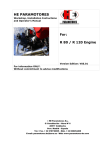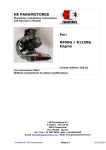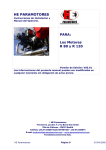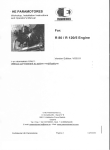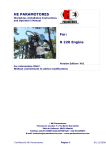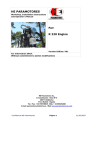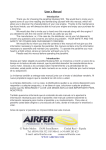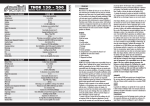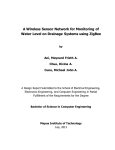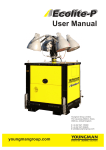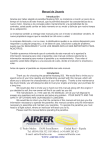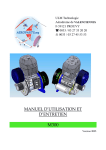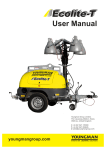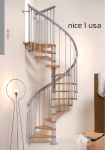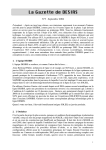Download HE PARAMOTORES - BlackHawk Paramotor
Transcript
Introduction Congratulations on choosing the R 0 / R 12 engine type. The HE Paramotores engine type R 0 / R 12 have been developed exclusively for use in paramotoring, which must only be run mounted with specific propellers, using adequate oil type and fuel. You should also comply with all the flying rules in your country. Warning: Before starting with installation and operation of the engine, observe the installation instructions and Operator’s manual and follow all instructions. Warning: This engine performs better as comparable products. Repeating symbols Warning: Identifies an instruction, which if not allowed may cause injury or endanger the life of the pilot, mechanic or third party. Attention: Denotes an instruction which if not followed may severely damage the engine. Non-compliance might lead under certain conditions to health hazards. Note: information useful for better execution and understanding of instructions. Ö Denotes a working operation 9 Denotes a checking operation Confidencial HE Paramotores Página 3 30/03/2007 1. Installation instructions for HE Engine Type R 0 and R 12 a. General precaution and safety information for engine installation Warning: For the best possible engine operation, compliance with the following advice regarding installation of engine and equipment is required. Warning: Modifications on engine or equipment are not allowed. Warning: Besides the engine–specific installation advice, also take note of information from the respective chassis manufacturer. b. Engine removal from the crate All packing material should be disposed of accordingly. The engine carton contains the following parts: Qty. 1 1 1 1 2 1 1 4 2 Part-no MOT0001/2 SCA0010 CON0002/3 ESC0001/2 SCA0006 CSA0002/3 Description HE Motor R 0 / or R 12 Workshop, Installation Instructions and Operator’s Manual Engine identity card Air filter Righetti Ridolfi Spark plug NGK BR10 Es BR9 Es Application Summer and winter spark plug Exhaust system Walbro Carburettor Mounting sets HE stickers Subject to change Attention: If engine is placed on a horizontal surface, take care not to damage the electrical wiring of the starter mechanism. Engine type R 12: This engine type is identical to the R 0 except for: Qty. Part-no Description Application 1 BMO0009 Cylinder head 1 BMO0010 Cylinder 1 BMO0011 Piston 1 ESC0002 Exhaust system 1 BMO0012 Crank shaft These three parts change the characteristic of the engine, details to follow in the next chapter. Note: An engine identity card stating date of delivery, company’s name and motor’s identification number. Note: The data entered in the engine identity card is required for verification of a warranty claim. Without a completely filled in identity card no warranty claim will be granted. Confidencial HE Paramotores Página 5 30/03/2007 c. Replenishing of oil level The reduction compartment will have already been filled with the appropriate amount of oil by the engine manufacturer. However, after a certain number of hours, it may be necessary to replenish the reduction compartment with appropriate oil: Ö Withdraw the three bolts that maintain the reduction compartment onto the engine bloc and bring the reduction compartment down; Ö Unscrew the venting valve 1; Ö Drain all the oil into a recipient and then slowly fill in oil of specification Mouwan Gear 80W90 (www.kripton.es) until 0,055 l./1,7 fl OZ (US) are in the compartment. Ö Fit the venting screw hand tight and put the reduction compartment back into place with the three screws (make sure that they are well tightening). Ö Dispose of the used oil in a recycling container. Attention: When placing the engine on a horizontal surface, take care not to damage the electrical wiring of the starter mechanism. 1 Note: this operation is better conducted when the engine has been previously warmed up in order to liquefy the oil. Note: use a syringe to fill the reduction compartment. Confidencial HE Paramotores Página 6 30/03/2007 d. Engine suspension on Chassis If the frame of the chassis was specially prepared to receive the HE Paramotores R0 and/or R 12 engine, then 2 steel plats with two holes each are welded on the two frame tubes. The four holes form a “rectangular” shape of 19 cm on the top side, 13.5 cm on the bottom side and 13 cm on both sides. The engine is tightened into position with four 8mm bolts and four lock nuts. 19 cm 13 cm 13 cm 13,5 cm e. Fitting of the spark plug Ö With the engine a spark plug of the type NGK BR 10 EG (summer) or NGK BR 9 EG (winter) get supplied. 9 Verify electrode gap of spark plug. Adjust as required. Note: The electrode gap of spark plug should be 0,5 mm/0,020 in to 0,6 mm/0,024 in. Only slight bending of the ground electrode is permitted. Ö Fit supplied spark plug and tighten to 24 Nm/212in.lb. Ö Put spark plug cap or connector on spark plug. f. Installation and connection of the carburettor Ö Check that all the gaskets are properly fitted onto the laminar entry box and carburettor installation plat. Ö For the R 80 engines, make sure that the venting hole on the side of the laminar entry box and carburettor installation plat is clear and clean. Ö Remove the transport plug from the carburettor. Ö Fit carburettor into carburettor socket and secure with hose clamp in vertical position. Ö For the R 120, connect the outlet hose of the fuel pump with fuel inlet on carburettor Note: each time this operation is conducted make sure to use a new set of gaskets. Confidencial HE Paramotores Página 7 30/03/2007 g. Installation of the Righetti Ridolfi Air Filter / silencer Ö Fit the carburettor socket 1 into the Air filter hole. Ö Attach the intake silencer with the supplied hose clamp 2 on the carburettor. Note: the carburettor socket is asymmetrical and can be turned so that the best possible position for maximum leg clearance can be achieved. 1 2 h. Installation of the exhaust system Note: On the underside of the carter two support lugs 1 are provided for vibration dampening of the exhaust system by rubber mounts (sinem blocks). 1 Attention: a rigid suspension of the exhaust system could result in fractures in the exhaust system. Ö Attach the high temperature resistant sinem blocks on the two support lugs on the underside of the carter. Ö Arrange supports so that the exhaust system from the exhaust socket on the cylinder to the muffler follows the straightest possible course. Also make sure that the sinem blocks are not over stressed. Ö For sealing of the ball joint between engine and exhaust system, secure the exhaust system on ball joint with the three supplied exhaust springs 2. 2 Attention: Do not over stress the springs 2 when fitting them. Attention: Condition of the exhaust system installation must be verified before each flight. Confidencial HE Paramotores Página 8 30/03/2007 i. Observation of the engine speed. To determine the best possible transmission ratio, the use of a rev-counter is required for observation of the speed limits. Note: HE Paramotores offers as an accessory the following indicating instrument: Tiny-Tach inductive rev counter. Note: This instrument is operating via an integrated battery. At engine start the readings of the connected sensors (inductive pick-up for engine speed (r.p.m.) will be displayed). This display will remain on for 5 seconds after engine stop. Attention: Pay attention to the manufacturer’s notes about connections and operation of the instrument. Attention: Use the original spark plug of 5 k resistance, so that the operation of the rev counter is not impaired. Wind at least three turns of the inductive cable between the ignition coil and spark plug connector and secure it with a cable tie on the ignition cable. Attach the instrument with cable ties for highest visibility and lowest inconvenience on the harness or chassis. and tightening spot. Attention: Use a vibration damping pad between the instrument Ö Secure induction cable with cable ties on the frame. Attention: The induction cable must be free of tensile stress; stress could damage the cable or could result in the malfunctioning of the cable and the instrument. Warning: Before engine operation, read the Operator’s Manual. Confidencial HE Paramotores Página 9 30/03/2007 2. Operating instructions for HE engines type R 0 and R 12 a. Technical description of the HE engines type R 0 and R 12 i. Type of engine Single cylinder two cycle engine with reed valve controlled inlet. Mixture lubrication is achieved by adding oil to the gasoline in a specified mixing ratio. ii. Ignition unit Easy manual start system: placed for over shoulder start. iii. Carburettor Walbro WG or WB (report to the Walbro user manual for any specific information). Report to engine tuning section for tuning details. iv. Intake silencer The intake silencer incorporates an air filter to clean the intake air. The intake silencer has been designed for optimum reduction of the air intake noise level and represents a tuned system with the engine. v. The exhaust system The exhaust system is designed as resonance system with an after muffler and represents a tuned system with engine. b. Fuel as media for engine operation For engine operation a mixture of unleaded gasoline and oil is required in different quantities varying upon the age of the engine and the model. Amount of oil for a given amount of petrol: R 0 Before 6 hours 3,0 % of the amount of (2 full tanks) unleaded petrol (U.P.) 95 with fully synthetic 2 stroke oil (e.g. CASTROL TTS). After 6 hours 2,5 % of the amount of U.P. 95 with fully synthetic 2 stroke oil. R 12 3,0 % of the amount of U.P. 95 with fully synthetic 2 stroke oil. 2,5 % of the amount of U.P. 95 with fully synthetic 2 stroke oil. Ö Pour small amount of fully synthetic 2 stroke oil in a clean fuel container. Ö Add amount of unleaded petrol 95 to obtain a good mixture. Attention: Too much oil in the fuel mixture could lead to engine trouble (e.g. cooking of the exhaust valve). Attention: Insufficient amount of oil in the fuel mixture could result in engine trouble (e.g. piston seizure). Confidencial HE Paramotores Página 10 30/03/2007 Warning: Do not try any different sorts of fuel. This could lead to engine damage to the intake system. Warning: When mixing fuel and fuelling do not smoke or allow naked flames. Petrol is highly flammable and explosive under certain conditions. Warning: Never perform mixing and fuelling in a closed room, handle fuel in well-ventilated area only. Note: Do not fill the fuel container to the top. Ö Shake well fuel container. Ö Pour fuel into fuel tank of the paramotor, Ö Close fuel tank and fuel container immediately after fuelling. Warning: Before each fuelling, shake well fuel container to ensure adequate mixing of the gasoline with the oil. Warning: Fuel the paramotor only when engine is not running. Warning: Make sure that the fuel will not splash onto hot engine components or equipment. Risk of fire and explosion! Warning: Pay attention to the safety advice of the paramotor manufacturer! Attention: Don’t spill fuel. Absorb spilled fuel with appropriate drying agent and ensure ecological disposal. Attention: Ensure that no contamination enters the fuel tank and the carburettor. Attention: Unleaded fuel has a limited storage life. Store only the quantity of fuel in a container which will be needed in the near future. Confidencial HE Paramotores Página 11 30/03/2007 c. Engine tuning i. Carburettor The engine is carburetted in the factory before delivering; do not try to modify the carburetion if you do not know how. A "full rich mixture" produces more vibrations and increases consumption. With a "lean mixture" the engine is more even but it gets overheated (usually there are "blanks" in the carburetion). After 10 minutes of working, the spark plug will start to get dirty with fuel waste. spark plug colour yellow/grey carburetion lean hazel brown/light brown brown/black right rich Diaphragm carburettor In order to work properly, the diaphragms (pump and valves) must be kept wet by the fuel mixture, after a long resting without fuel or after several working hours the diaphragms may need to be replaced. In case of doubts please do get in touch with us. The replacement may be necessary every year, the use of old diaphragms leads to an increasing leaning of the mixture and piston seizure. In some cases it may be necessary a seasonal carburetion setting, especially if you change of altitude, for such a setting please do turn to an expert. A idle too lean : Difficult start, while revving up the engine tends to stop idle too rich : The engine abates while leaving it at idle for ten sec. and it revs up slowly, excess of smoke. 2 R 0 and R12: Our carburettor is provided with a starter for the very first starting (cold starting). Flip up switcher A in position 2 for starting, in position 1 for functioning. C 1 D The little hole B at the front of the carburettor is used in the priming process before starting a cold engine (Push cautiously! Go to section 2. e.). You can set the carburetion at the desired revs. By the long black downward screw C. By turning it anticlockwise you rich the mixture, while the opposite you lean it. The basic setting is between 1,5 and 1,7 turns from the shut position. The C screw must be turned very gently, always verifying the cleanness of the "passage" (the point where the nozzle of the idle enters the nozzle of the full, at about half revs.) in revving up. If the engine pops, you tighten it; if it abates you loosen it. B The D screw sets the revs at idle, by opening the butterfly valve (for additional information please contact your local distributor). If the idle is high, turn the screw in an anti clockwise direction. If the idle is low, turn the screw in a clockwise direction. Confidencial HE Paramotores Página 12 30/03/2007 R 12with WB37: The little hole D at the front of the carburettor is used in the priming process before starting a cold engine (Push cautiously! Go to section 2. e.). At high revs, you can set the carburetion at the desired R.P.M. By turning the long black screw A anticlockwise, you rich the mixture, while the opposite you lean it. The basic setting is between 1,5 and 1,7 turns from the shut position. The A screw must be turned very gently. A B C D At low revs, you can set the carburetion at the desired R.P.M. By turning the small black screw B anticlockwise, you rich the mixture, while the opposite you lean it. The basic setting is between 0,5 and 0,7 turns from the shut position. The B screw must be turned very gently. The C screw sets the revs at idle, by opening the butterfly valve (for additional information please contact your local distributor). If the idle is high, turn the screw in an anti clockwise direction. If the idle is low, turn the screw in a clockwise direction. Confidencial HE Paramotores Página 13 30/03/2007 ii. Propeller Photos Ref. HE Name Description Quant./ unit Propellers HEL0005 HEL0006 HEL0007 HEL0008 Wooden Propeller R 0 Carbon Propeller R 0 Wooden Propeller R 12 Carbon Propeller R 12 x1 x1 x1 x1 Only the propellers listed in the above table have been properly tested and are adapted to our motors. Attention: Never run your engine without an adequate propeller fitted! You may damage your engine. Warning: Take care whilst operating your engine with prop on!!! Never operate an engine with prop if not properly fitted onto an adapted chassis and without a frame securing you from the propeller. Warning: Do not operate engine with propeller if you have not followed a certified paramotoring course and are not qualified to handle these machines. Warning: HE Paramotores does not take any responsibility for bad handling and dangerous behaviours with its engines. Attention: HE engines type R 0 and R 12 have been developed only for paramotoring purposes. Any other use will not be covered by the engine’s guarantee. Confidencial HE Paramotores Página 14 30/03/2007 d. Characteristics and Operating limits i. R 12 Static Thrust Engine R 12 Twin blade propeller in wood Test conditions T 12°C - P 1048 Mb - UR 45% Altitude 700 m Engine revs Consumption in 1/hr 9700 and more 4.5 8000 3 7000 2 6000 1 (*) depending on prop. size, material, shape and on meteorological conditions, altitude. Technical characteristics C.c. cm³ 12 Compression rates cm3 11/1 0D[Revs/min700 Weight of the engine including: the muffler, exhaust pipe, the air filter and the propeller. 13 Kg Laminar aspiration with a carburettor Walbro WG 8-1 Cylinder of aluminium with ceramic coating in Nikasil System of unloading to resonance. Helicoïdal gear reduction Manual pull start In flight consumption with at 9000 revs, 4 litres/hour Power /torque table Rev engine Hp kW Kgm 6000 8 5,91 6,08 7200 14 10,44 10,64 8500 17,5 13,05 12,92 9700 20 15 15,20 Confidencial HE Paramotores Página 15 30/03/2007 ii. R 0 Static Thrust Motor R 0 Twin blade propeller in wood Test conditions T 12°C - P 1048 Mb - UR 45% Altitude 700 m Consumption in 1/hr Engine revs 9400 3.5 8000 2.8 7000 2 6000 1 (*) depending on prop. size, material, shape and on meteorological conditions, altitude. Technical characteristics C.c. cm³ 80 Compression rates cm3 8/1 0D[Revs/min9400 Weight of the engine including: the muffler, exhaust pipe, the air filter and the propeller. 12 Kg Laminar aspiration with a carburettor Walbro WG 8-1 Cylinder of aluminium with ceramic coating in Nikasil System of unloading to resonance. Helicoïdal gear reduction Manual pull start In flight consumption with at 9000 revs, 3 litres/hour Power /torque table Rev engine Hp kW Kgm 3000 6 4,47 4,56 4800 9 6,71 6,84 7600 12 8,95 9,12 9400 16 11,93 12,16 Warning: The engine is only allowed to be run at peak performance after reaching the specified the specified operating temperature of 160 °C. Warning: The maximum operating temperature of the engine must not be exceeded. If the temperature is too high (above 240°C), it may result in piston seizure. Note: Dirt must be cleared at regular intervals to achieve the best cooling performance. Attention: Keep your engine clean at all time!!! Confidencial HE Paramotores Página 16 30/03/2007 ii. R 80 Static Thrust Motor R 80 Reduction 1:4 Twin blade propeller in wood 49x26 R Test conditions T 12°C - P 1048 Mb - UR 45% Loc. Madrid 04/11/2004 Altitude 700 m Consumption in 1/hr Engine revs Kg in thrust (*) 9400 3.5 48 8000 2.8 41 7000 2 31 6000 1 22 (*) depending on prop. size, material, shape and on meteorological conditions, altitude. Technical characteristics C.c. cm³ 80 Compression rates cm3 8/1 Power Hp 16 kW 11.9 Revs/min 9.400 Weight of the engine including: the muffler, exhaust pipe, the air filter and the propeller. 12 Kg Laminar aspiration with a carburettor Walbro WG 8-1 Cylinder of aluminium with ceramic coating in Nikasil System of unloading to resonance. Helicoïdal gear reduction Manual pull start In flight consumption with at 9000 revs, 3 litres/hour Power /torque table Rev engine Hp kW Kgm 3000 6 4,47 4,56 4800 9 6,71 6,84 7600 12 8,95 9,12 9400 16 11,93 12,16 Warning: The engine is only allowed to be run at peak performance after reaching the specified the specified operating temperature of 160 °C. Warning: The maximum operating temperature of the engine must not be exceeded. If the temperature is too high (above 240°C), it may result in piston seizure. Note: Dirt must be cleared at regular intervals to achieve the best cooling performance. Attention: Keep your engine clean at all time!!! Confidencial HE Paramotores Página 16 30/03/2007 e. Engine start and operation Prior to engine start verify the following: 9 Before starting the engine, ALWAYS check that the throttle cable is not jammed open! Do this by squeezing the throttle lever and allow it to release sharply. Look around and make sure there is no one nearby and SHOUT “Clear prop!” to warn others of your intentions. Warning: Never start the engine without the propeller!! A two-stroke engine has a low mass and its maximum speed is reached in fractions of a second when no load is applied. It is not equipped with a rev limiter and the mechanical parts are only designed to work at the rotation speeds reached with the propeller. Exceeding this speed will have catastrophic effects on the engine. 9 Fuel tank full, STARTING A COLD ENGINE If the engine is being started for the first time, or it has run out of fuel you will need to prime the fuel system. Gently press the short, fitted wire prod through the hole in the centre of the plate on the propeller side of the carburettor whilst simultaneously squeezing the pump bulb. This allows you to push fuel through the fuel filter and into the carburettor. Squeeze the bulb just once and watch the fuel pass through the clear filter. Stop, pull the wire prod back and gently squeeze the bulb again. The carburettor is primed. When starting a cold engine pull the choke wire towards you, then start the engine and wait until it stops running. Then return the choke wire to the neutral position and start the engine again using a little throttle then let it tick over until warm. The engine will normally start without any problems unless the outdoor temperature is very low. In this case repeat the use of the choke. Note: To avoid damaging the starter mechanism, always use the starter as follows: hold the starter handle with one hand, brace yourself against the frame with the other and gently pull the starter feeling for the point of maximum resistance. Once there, give the starter cord a short sharp pull. Normally the engine will start up immediately. If the engine does not start, don’t keep pulling the starter, it will not help and it could even be dangerous. Save your energy and find the source of the problem. It is nearly always an excess of fuel – the engine has been flooded. Unlike a lot of paramotor engines the R 80 has it’s spark plug “head up” so it’s not prone to flooding. Over zealous use of the fuel primer pump will, however, flood it and it won’t start no matter how many times you pull the cord (!) If the engine has become flooded, simply remove and wipe clean the spark plug. Tip: use a cigarette lighter to burn off the excess fuel on the spark plug STARTING A WARM ENGINE Follow the same procedure as before but do not use the choke. The engine needs to reach its working temperature – allow it to warm up for at least a minute before revving it. f. Stopping the engine Press the Kill switch button for more then 3 seconds. Warning: If not, you engine will restart. Confidencial HE Paramotores Página 17 30/03/2007 g. Running in procedure for the engine R-0: For the first two tanks of fuel, the engine should be run in with 2,5% of the amount of unleaded petrol (U.P.) 95 with fully synthetic 2 stroke oil (e.g. CASTROL TTS). The engine should be run in for approx 30 minutes before you start flying and during the first 5 minutes do not use full throttle. The engine will be fully run in once it's consumed 20 litres of fuel, the mix then put bring the mix to 2,2%. R-12: For the first two tanks of fuel, the engine should be run in with 3,5% of the amount of unleaded petrol (U.P.) 95 with fully synthetic 2 stroke oil (e.g. CASTROL TTS). The engine should be run in for approx 30 minutes before you start flying and during the first 5 minutes do not use full throttle. The engine will be fully run in once it's consumed 20 litres of fuel, the mix then put bring the mix to 3%. R-0/R-12: The life of an engine that has been correctly run in will be increased by 100%. A badly run in engine has a high risk of being seriously damaged in its first hours of flight. The best way to run in your new R 0 is to vary the load on it during the initial running minutes for example: Start & run engine for 2 Minutes; stop engine for 2 min. Start & run for 5 Minutes; stop engine for 5 min. Start & run engine 10 min; stop engine for 5 min. You should frequently change the throttle setting, gradually increasing & decreasing the revs but avoiding full throttle. Never “blip” the throttle because you will place the centrifugal clutch under abnormal loads. During this period of initial running we advise you to check the security of all the mechanical parts as well as all the nuts, bolts and fittings before you start the engine. You can fly your R 0 during the first 30 minutes of running in, but do not use full throttle more than strictly necessary. If you are a heavy pilot we recommend you to run your engine on the ground for at least an hour before flying it. After the first half an hour, check all the nuts, bolts and fittings, especially those on the engine and the propeller. This check should ideally be made every time you fly but at the very least be done every 5 hours. It is possible that the engine may overheat during the running in period. If this happens you'll notice a loss of thrust and you should switch the engine off and let it cool down, or at least, immediately reduce the revs. An overheated engine can usually be detected by back firing noises or by oil stains on the cylinder cooling fins. If the engine should overheat the bolts on the cylinder head may become slack and should be checked – do not over tighten them! Don’t mistake overheating for poor carburettor adjustment or dirt in the filter both of which may also cause a loss of thrust. Warning: Always wear appropriate clothing to operate your paramotor (Helmet, gloves, proper shoes…). Warning: Do not touch the engine, the exhaust system during and immediately after motor operation. Risk of burning! Warning: During operation beware of body or clothing contact with propeller or engine!!! Warning: Comply with the safety advice of the paramotor manufacturer. Warning: Inspect any part prone to wear before and after each flight in accordance with the directive of the paramotor manufacturer. Warning: Keep the running-in procedure as directed. Confidencial HE Paramotores Página 18 30/03/2007 Warning: operate engine only in the specified limits. Warning: Never engine with an empty fuel tank. Note: Three flights of 5 to 10 minutes should be sufficient to warm up your engine when new. Note: To start with do not operate your engine for longer periods then stated above. Note: You must run-in the engine before flying. Note: Do not rev. up for five minutes while running-in. Note: The running-in is over after consuming 10 litres of petrol. Note: The lifespan of your engine can double with a proper running-in, while with a bad one you may damage it since the very first hours of working. Note: In the first phase of the running-in the engine must be switched on and off following the cycles below: engine 1° cycle 2° cycle next on 2 minutes 5 minutes 10 minutes 2 minutes 5 minutes 5 minutes. off Note: While on, the engine must be gently set at different revs, starting from the lowest up to the highest. Warning: Repeated revving are unsuitable, the clutch may be surcharged. After each switching off, do carefully check all the mechanic parts, bolts and knots. After at least 30 minutes of work you can fly avoiding high revs. for too a long time. A heavy pilot requests more power to fly, in such a case is better to run the engine on the ground for at least 1 hour. After the first 30 minutes of run, do check all the bolts, knots and screws, particularly those of the engine and the prop as well. Those of the engine (bolts and knots) must be checked every 5 hours of flight. Engine overheating may occur while running-in; you can recognize it by a loss of power. In this case is very dangerous to keep it on, it is better shutting off and let cooling, OR, AT LEAST SLOW DOWN BELOW 5000 RPM before applying more power.A loss of power may occur because a mixture too lean, following a wrong carburettor setting or dirty in the filter, do check for such possibilities before restarting the engine In case of overheating it is advisable to check the head screws to verify the seal of the motor head, see locking torques. Usually a loss of seal can be perceived by dull strokes at starting or by oil leakage, once the air conveyer is removed. Confidencial HE Paramotores Página 19 30/03/2007 h. Maintenance Warning: Change lock nuts for new ones if untightened! MAINTENANCE - BEFORE EVERY FLIGHT IT IS IMPORTANT THAT YOU; 9 Check that the propeller is not damaged, that it is secure and that it turns smoothly without making noises. BE CAREFUL - never be tempted to put your hands in the paramotor once the engine is started even though the propeller is not moving. 9 Check that the exhaust pipe is correctly held in place and that it is not damaged; check that all of the engine parts, air filter and carburettor, petrol tank and pipe, spark plug and starter cable are fitted correctly and are secure. Check that nothing can come loose in flight because if anything hits the propeller it will be a danger for the paramotor, the pilot and other people. 9 Check the welding on the chassis, especially where the engine is located. Check that the netting is securely held in place. Check that none of the paraglider lines are in the way of the propeller and that nothing else can be sucked in. Attention: If in doubt, do not take off! When you have landed, use a clean cloth to remove traces of oil and dust from the engine and the propeller. This is the best way to discover any potential problems. MAINTENANCE - EVERY 5 HOURS 9 Check the spark plug. The plug should be a mid-brown colour and the distance between the electrodes should be 0.5 mm. 9 Check all bolts. Take special care with the bolts on the cylinder head - they should be at a torque setting of 9Nm (0.9 Kgm). To avoid damaging the cylinder head this check should be made with the engine cold and the adjustment of the screws should be made in a diagonal crossway fashion. Clean the inline fuel filter. 9 Check the bolts on the propeller. It is important that the propeller bolts are tight but equally tight. Make sure that you do not crush the propeller by over tightening the bolts. 1.0 Kg/m is the maximum recommended torque. MAINTENACE - EVERY 20 HOURS 9 Change the spark plug and check that the spark plug cable has not chafed. 9 Check all bolts and lock nuts in general and in particular check the nuts on the base of the exhaust pipe. Do not over tighten the exhaust manifold bolts. 9 Check, whilst engine warm, the four bolts on top of the cylinder head. Pressure of tightness should be 12 N.M (8.85 lbf.ft) Confidencial HE Paramotores Página 20 30/03/2007 MAINTENANCE - EVERY 50 HOURS 9 Check the general condition of the frame and chassis. 9 Check the play and thickness of the clutch's friction plates. The clutch bell should be at least 1.2 mm thick. Clean the interior of the clutch bell with a clean cloth and remove any dust. 9 Decoke the piston crown, the exhaust port and cylinder head. 9 Check the condition of the piston ring and that they are not sticking in the ring groove. MAINTENANCE - EVERY 100 HOURS 9 Check the all the engine seals and replace if necessary. 9 Replace the piston needle bearing and ring. MAINTENANCE -EVERY 200 HOURS 9 Check the engine bearings and replace if necessary. 9 Replace the piston and the engine seals. MAINTENANCE - EVERY YEAR 9 Check the carburettor’s membrane. 9 Check the seals on the crankcase. 9 Check the rubber engine mounts and elastic parts. We recommend that engines with more than 200 working hours should be factory overhauled in order to replace any possibly deteriorated parts. i. Preservation of engine and equipment For long periods out of operation (winter time), make sure that the engine will be properly preserved. Ö Detach carburettor, drain fuel from fuel system and close carburettor openings to ensure that no dust or dirt can enter. Ö Close intake and exhaust port of engine so that they are air tight with adhesive tape. Ö Apply oil on exhaust systems to prevent corrosion. Confidencial HE Paramotores Página 21 30/03/2007 j. Trouble shooting Possible cause Solution mixture too rich or too poor follow the procedures DIFFICULT STARTING : cold starting go to "engine starting" go to "carburetion" hot starting after switching off when the engine is still hot different troubles air bubbles in the circuit charge the circuit before starting the engine, go to "engine starting" power failure to the spark remove it and check mixture too poor go to "carburetion" vapour look wait few minutes or use a colder spark failure un the electric circuit go to power failure different troubles with float type carburettor the gas from the float chamber spread on the pump go to "engine starting" different troubles with diaphragm carburettor after a long resting the carburettor is "dried" go to "engine starting" UNEVEN POWER (high revs. power loss) AND UNSTEADY IDLING in case these troubles show simultaneously carburetion lean because of carburetion gas shortage air suction in the fuel circuit go to "carburetion" replace pipes, filters and joints obstructions in the fuel flow • • • replace the gas filter clean the inner filter in the carburettor clean the needle jets and fuel ways inside the carburettor go to carburettor maintenance the carburettor doesn't provide enough fuel • • • clean the intake pressure hole the carburettor gasket is broken or badly mounted replace the diaphragms* * must be done when fuel swiftly goes back to the fuel tank when switching off the engine Confidencial HE Paramotores Página 22 30/03/2007 carburetion lean due to an excess of air carburetion go to "carburetion" fuel suction through the sump or its gaskets • • check and waterproof by suitable products all the junctions and gaskets replace the crankshaft gaskets EXHAUSTION GASES carburetion too rich • • go to "carburetion" too much oil in the mixture unsuitable oil POWER FAILURE spark plug electrodes distance 0,5 mm (tool supplied) distance coil / fly-wheel 0,3 ; 0,5 mm short circuit on the switch off circuit check thermostat (if any), the switch off button, the coil electric wire to the terminal oil lack check the oil level NOISE : to the speed-reducer bearings or gears damaged to the muffler intake to the propeller mountings or muffler manifold fix or replace the mountings muffler ineffectual replace glass wool muffler disconnected damaged by foreign bodies fix or replace before taking off again check the engine bolts and nuts Confidencial HE Paramotores Página 23 30/03/2007 3. Warranty a. Warranty conditions / Warranty card i. Period HE Paramotores as manufacturer, warrants directly or through their authorized HE Paramotores distributors from the date of sale to the first consumer, every HE Paramotores R 0 and R 12 engine, sold as new and unused, and delivered by an authorised HE Paramotores distributor for a period of the earliest of: Note: 6 consecutive months for private use owners; Note: or 12 consecutive months for engines bought through our distributors’ network. ii. What an authorized HE Paramotores distributor will do The authorized HE Paramotores distributor will, at its option, repair and / or replace components defective in material and/or workmanship under normal use and service, with a genuine HE Paramotores component without charge for parts or labour, during said warranty period. All parts replaced under warranty become the property of HE Paramotores. iii. Condition to have the warranty work performed You must present the authorized HE Paramotores service-centre, the hard copy of the HE Paramotores warranty registration card and/or proof of purchase delivered to the customer from the selling dealer at the time of the purchase. iv. Exclusions – are not warranted Note: Normal wear on all items Note: Replacement parts and/or accessories which are not genuine HE Paramotores parts and/or accessories. Note: Damage resulting from the installation of parts other then genuine HE Paramotores parts. Note: Damage caused by failure to provide proper maintenance as detailed in the operator’s manual. The labour, parts and lubricants costs of all maintenance services, including tune-ups and adjustments will be charged to the owner. Note: Paramotor engines used for racing or commercial purposes. Confidencial HE Paramotores Página 24 30/03/2007 Note: All optional accessories installed on the paramotor engine (the normal warranty policy for parts and accessories, if any, applies). Note: Damage resulting from running the paramotor engine without a propeller. Note: Damage resulting from modification of the paramotor engine not approved in writing by HE Paramotores. Note: Damage caused by electrolysis. Note: Cold seizure and scuffing. Note: Use of gear reduction not designed by HE Paramotores. Note: Use of propeller not referenced by HE Paramotores. Note: Losses incurred by the paramotor engine owner other then the parts and labour, such as, but not limited to, mounting and dismounting of the engine from the paramotor, loss of use, transportation, telephone calls, taxis and any other incidental or consequential damage. Note: Damage resulting from accident, fire or other casualty, misuse, abuse or neglect. Note: Damage/rust/corrosion/premature wear to the engine caused by water ingestion. Note: Damage resulting from sand/stones infiltration. Note: Damage resulting from any foreign material ingestion. Note: Damage resulting from service by an unqualified mechanic. v. Expressed or implied warranties This warranty gives you specific rights, and you may also have other legal rights which may vary from state to state, or province to province. Where applicable this warranty is expressly in lieu of all other expressed or implied warranties of HE Paramotores, its distributors and selling distributors, including any warranty of merchantability or fitness for any particular purpose; otherwise the implied warranty is limited to the duration of this warranty. However some states or provinces do not allow limitations on how long an implied warranty lasts, so the above limitation may not apply. Neither the distributor, nor any other person has been authorised to make any affirmation, representation or warranty other than those contained in this warranty, and if made, such affirmation, representation or warranty shall not be enforceable against HE Paramotores or by any other person. Confidencial HE Paramotores Página 25 30/03/2007 HE Paramotores reserves the right to modify its warranty policy at any time, being understood that such modification will not alter the warranty conditions applicable to paramotor engines sold while the above warranty is in effect. vi. Consumer assistance procedure If a problem or other difficulty occurs, please contact: Note: Authorized HE Paramotors service centre or, Note: Authorized HE Paramotors distributor. vii. Validity Warranty will only be valid if the end-user completes this registration card as soon as the paramotor engine goes into service, and returns it to the authorized HE Paramotor distributor (see in our Internet site Distributor network) of the area in which the paramotor engine is firstly operated. viii. Warning! Warning: This engine by its design is subject to sudden stoppage! Engine stoppage can result in crash landings. Such crash landings can lead to serious bodily injury or death. Never fly the paramotor equipped with this engine at locations, airspeeds, altitudes, or other circumstances from which a successful no-power landing cannot be made, after sudden engine stoppage. Paramotors equipped with this engine should only fly in daylight VFR conditions. Warning: This is not a certified paramotor engine. It has not received any safety or durability testing, and conforms to no aircraft standards. It is for use in experimentale, uncertified paramotors and vehicles only in which an engine failure will not compromise safety. User assumes all risks of use. And acknowledges by this use that he knows this engine is subject to sudden stoppage. Confidencial HE Paramotores Página 26 30/03/2007
























